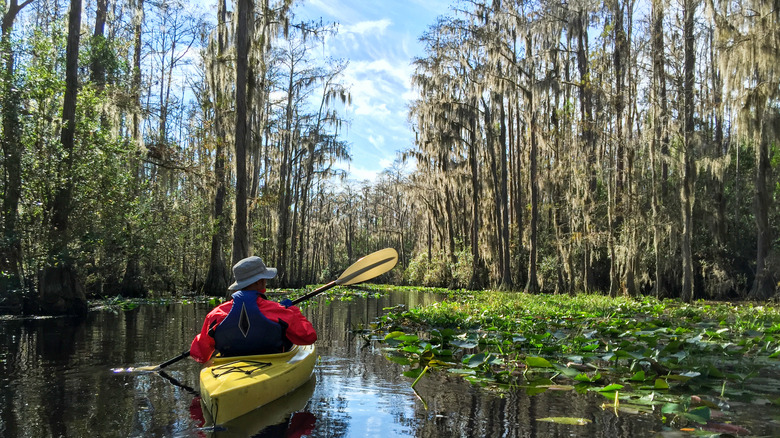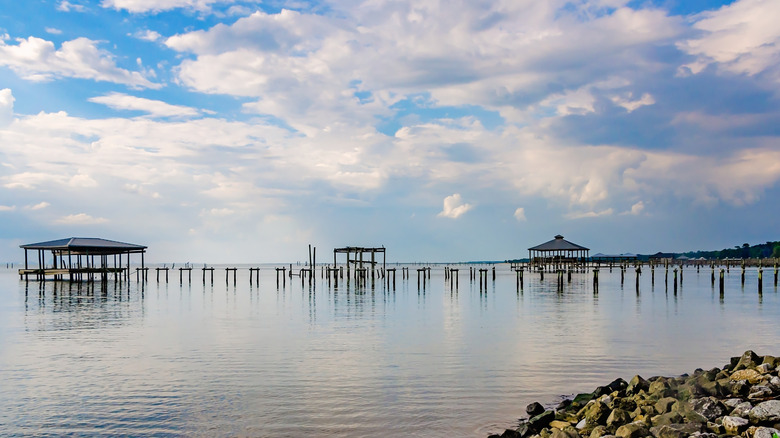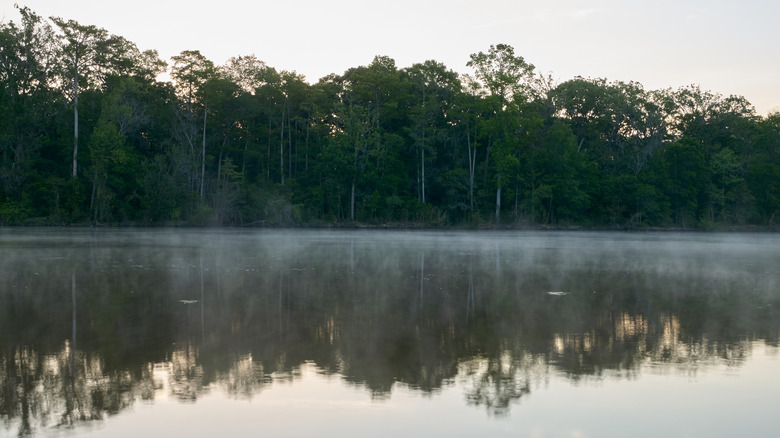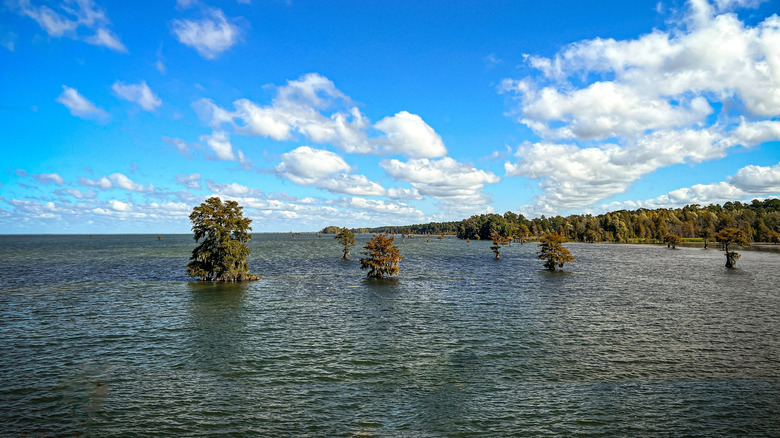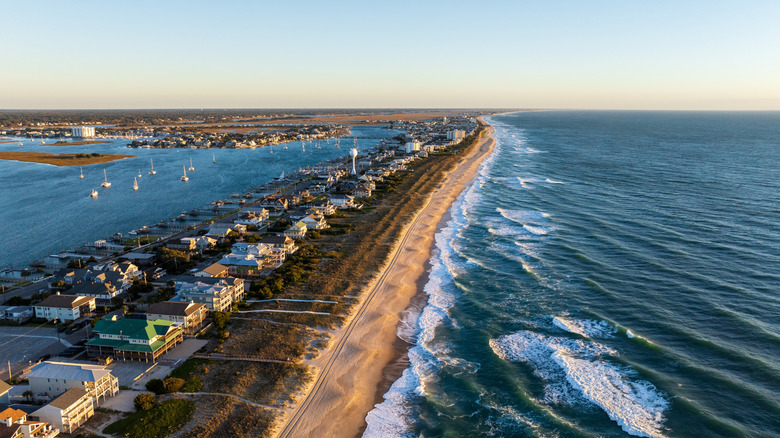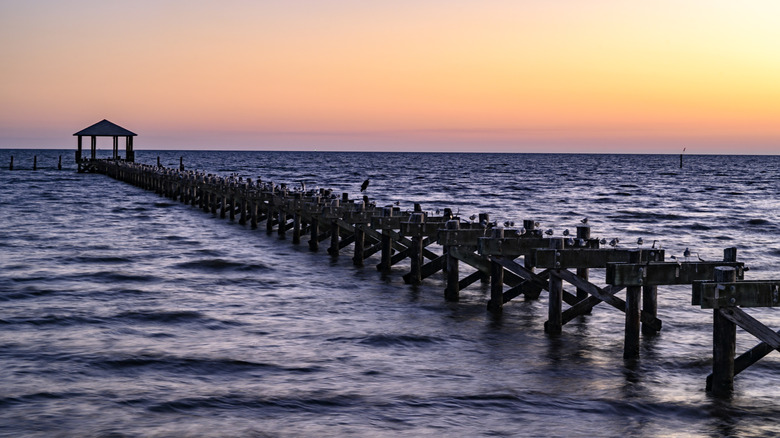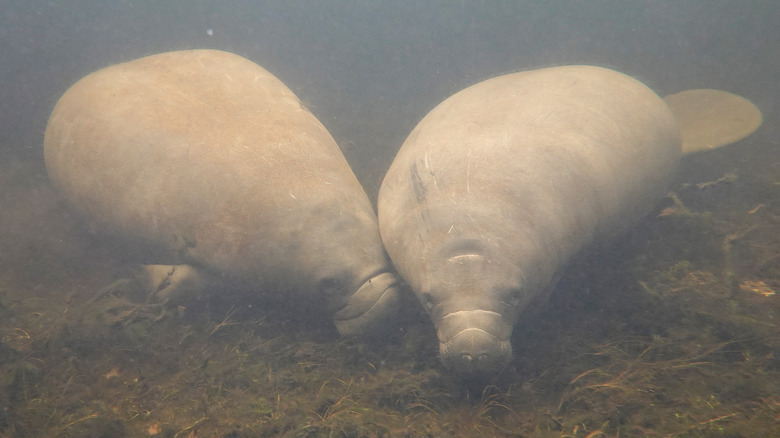The Best Places In America To See Wild Manatees (That Aren't Florida), According To Research
When you think about trying to spot manatees in the United States, you probably think of Florida first. There's a good reason for this. They mostly live in and around the state of Florida. Most people head to spots like Madison Blue Spring State Park to see manatees in the beautiful blue freshwater spring hidden in the woodlands or Merritt Island National Wildlife Refuge to see these incredible animals that seem to shimmer blue in the mesmerizing bioluminescent waves. Those aren't your only options, though. While manatees don't generally swim very quickly, preferring to drift through the water and graze on tasty water plants in their own time, they can travel long distances. Utilizing tagged animals and reports from people who have seen them, researchers have found that manatees travel to Alabama, Georgia, South Carolina, North Carolina, and Mississippi. Occasionally, they make it all the way to Louisiana and Texas. In rare instances, they have been seen as far north as Massachusetts.
They are rare outside of Florida, but if you are in the right spot at the right time and wear a pair of polarized sunglasses, you might get to see manatees in the wild. Whether or not you get lucky and catch a glimpse, you can help manatees by being cautious while boating, staying in deep water, and avoiding seagrass beds. If you accidentally end up over seagrass, trim your motor or turn it off completely and make your way out slowly. If you're lucky enough to spot a manatee, give it some space. You will be rewarded with a rare chance to see how these creatures behave in the wild. Afterwards, you can share your sighting with the Dauphin Island Sea Lab at manatee@disl.edu to help researchers learn more about manatees.
Alabama
If you're staying in Fairhope, Alabama, one of the South's best artsy little cities, and take a walk along the pier and look out at the water, it might be hard to imagine a 10-foot-long, thousand-pound creature floating beneath the waves. However, this is Mobile Bay, one of the best places to look for manatees outside of the state of Florida. You might even spot Bama, the first-ever manatee tagged in Alabama.
As surprising as it might sound, manatees in Alabama are nothing new. Researchers have found fossilized evidence of manatees in Mobile Bay [pictured], so they've been there a long time. Manatee sightings are still rare, but reports from the Alabama Department of Conservation and Natural Resources' West Indian Manatee Study show that there are more manatees in the state than ever. Simultaneously, researchers from the Dauphin Island Sea Lab have reported that manatees are staying in the bay later into the year than ever. That means that you have at least a slim chance of seeing one all year long, not just when they migrate in from Florida in the spring (though your best bet will still be in warmer months).
Travelers should explore Dog River, where manatees (including Bama) have even been seen gathering to mate, causing big splashy spectacles as the multiple enormous mammals chase each other around. Consider taking a Manatee Habitat Cruise from Mobile through Alabama's Historic Blakeley State Park to Mobile Bay and Dog River. They are organized with the Manatee Sighting Network to visit the best spots. If you don't see a manatee, you'll still get to learn a lot about them and the kinds of places that they love to be, so it's worth it even if the animals themselves don't make an appearance.
Georgia
If you're hoping to see the charming whiskers of a friendly manatee in the Peach State, you might just get your wish between April and October, with the best chance during the hot summer months. Manatees have been spotted along the coast, grazing in salt marshes, and swimming in Georgia's waterways. While there are still a lot of questions about manatees in Georgia, there may be more in the state than people think. Researchers from the Clearwater Marine Aquarium Research Institute, the Georgia Aquarium, and the Georgia Department of Natural Resources have been working on satellite tagging manatees that travel through Georgia to learn more about their movements.
One of the best places to start your search is in Georgia's blackwater rivers. The Satilla River in Camden County is particularly striking and worth a visit, whether or not you see any manatees. Thanks to the tannins in the water, the river looks deep brown in the light and almost black in the shade. Consider paddling the Satilla River Water Trail to see it all. While you're in Camden, explore the St. Mary's River, too. It's also a blackwater river, and it's right on the border with Florida, so it's no surprise that manatees from the neighboring state pay it a visit. The wildlife refuges along the mighty Ogeechee River, like Wassaw National Wildlife Refuge, also have the kind of salt marshes manatees love.
Finally, head to the Altamaha River [pictured] in Glynn County. It, too, has a water trail to explore, but you should also check out Wolf Island National Wildlife Refuge. This refuge on the Altamaha is made up of three islands and salt marshes and is known as one of the best destinations for birdwatchers, but manatees have been documented here. They even breed within the refuge.
South Carolina
While there have been recorded sightings of manatees in South Carolina since the Victorian Era, no one knew just how commonly they visited the state until researchers from the South Carolina Department of Natural Resources began requesting that the public report their sightings. Since then, reports have been on the rise. Paired with several manatees that researchers have tagged with satellite transmitters visiting South Carolina, all signs indicate that they are regular visitors to the Palmetto State. Typically, people start seeing manatees in May, and they stay in the area until November.
The beautiful seaside town of Beaufort is the perfect destination for visitors hoping to see some of the state's visiting manatees. While the area's creeks, including Broad Creek and Skull Creek, can be murky, which can make it tricky to see them as they float by, keeping your eyes open for big swirling ripples on the surface can help you detect spots where manatees might be underneath. They are mammals who breathe air, not water, so if you watch long enough, you may see them bob to the surface for a moment to take a breath. You may also want to peer into the water while strolling along Shelter Cove Marina and the Harbour Town Marina, both of which have frequent reported manatee sightings. You might also spot manatees at Hidden Cove Marina, or any of the other the secret freshwater coves of Lake Moultrie [pictured].
North Carolina
In November 2024, an underweight and sickly manatee was found in North Carolina's Tar River. She was far too cold and had to be rescued and rehabilitated, and was eventually successfully re-released into the warmer waters of Florida. While this manatee had stayed too long in North Carolina and suffered due to the chilly water, it wasn't a fluke that she was there at all. In warm weather, manatees often travel up the coast. You might have seen native grass and wildflowers blowing in the wind in the valleys in America's most visited national park, the Great Smoky Mountains, but there are entirely different meadows waving beneath the North Carolina waves. Sea grass, which manatees love to graze on, is vital to their survival, and the Tar Heel State has plenty.
Sightings remain rare, but in the warm summer months, individuals and herds can sometimes be seen in the Intracoastal Waterway, sometimes close to one of the best beach towns in North Carolina: Wilmington. In general, the southern third of the coast, especially between Hampstead Beach and Wrightsville Beach [pictured], is a good place to look for migrating manatees. Occasionally, they can also be spotted in rivers like the Tar River, Neuse River, and Cape Fear River. As long as they head back south to Florida before it gets too cold, they can graze there peacefully and give travelers and locals alike the chance to spot them. As the water in North Carolina grows warmer with the climate crisis, researchers expect to see more and more manatees around the state — and some might even stay all year long.
Mississippi
It has long been known that manatees regularly visit the northern Gulf of Mexico between April and October (with some reports to the Dauphin Island Sea Lab indicating that they may be safe staying in winter, too) and can be seen from coastal states like Mississippi. In 2024, researchers from the Grand Bay National Estuarine Research Reserve used drones to observe manatees breeding off the state's coast, indicating that it is a much more important habitat for them than was previously known.
While you may not have a drone, if you get very lucky, you may be able to see them for yourself in brackish rivers like Bernard Bayou or along the quiet docks of James Hill Park. On several occasions, manatees have even been seen from the popular Gautier, Mississippi restaurant Huck's Cove. While you probably won't see a manatee there most of the time, there is other wildlife in the area, including alligators, so if you decide to eat there on your travels, keep your eyes on the river. Your best option, however, might be to head to the Mississippi Sound. Thanks to data from one tagged manatee named Clog, it's clear that manatees spend plenty of time off the coast here. If you don't spot a manatee from the white sand beaches or while paddling your kayak through the waves, you might see dolphins. It's also worth visiting the gorgeous Grand Bay Wildlife Refuge to seek out the Brackish waters that feed straight into the sound. Sightings there are rare, but manatees do visit the refuge.
Methodology
To determine the best places to see wild manatees outside of their favorite haunts in Florida, we deferred to the experts. We utilized research from the respected nonprofit Save the Manatee to find out which habitats manatees like the most and to learn which other states have suitable conditions for them. To learn where the most manatees have been spotted and get some tips on how to observe them safely, we turned to publicly available data from the Dauphin Island Sea Lab's Manatee Sighting Network, which collects reports of manatees outside Florida and tracks and maps them. This study not only teaches us more about manatees and how to see them in the wild, but it also informs the U.S. Fish & Wildlife Service which waters are vital manatee habitats that will need to be protected for the future of the species.
To determine the best rivers, salt marshes, and coastal areas to look for manatees within individual states, we used a variety of sources, including the U.S. Fish & Wildlife Service and the Clearwater Marine Aquarium Research Institute for conservation efforts associated with consistent manatee activity. To narrow it down from general regions to specific destinations and activities that travelers can plan their trips around, we also checked state-specific sources, like the Georgia Department of Natural Resources, the South Carolina Department of Natural Resources, and the University of North Carolina Wilmington lab. Finally, before recommending any individual spot, we did a general search for news stories and social media posts to ensure that actual visitor experiences line up with the research and that people have actually seen manatees in these places in recent years.
